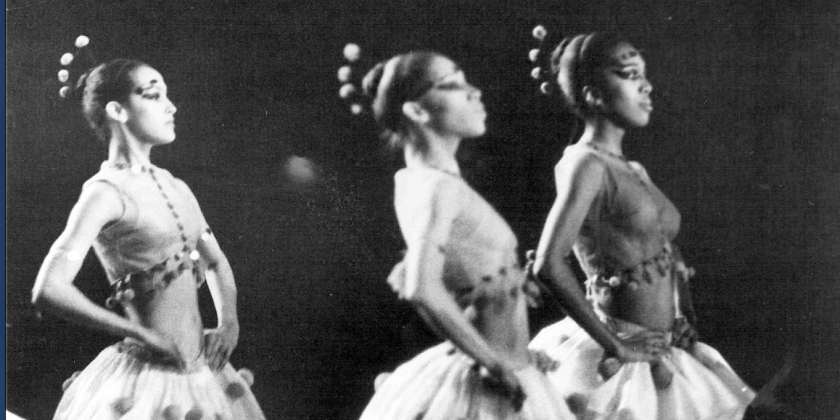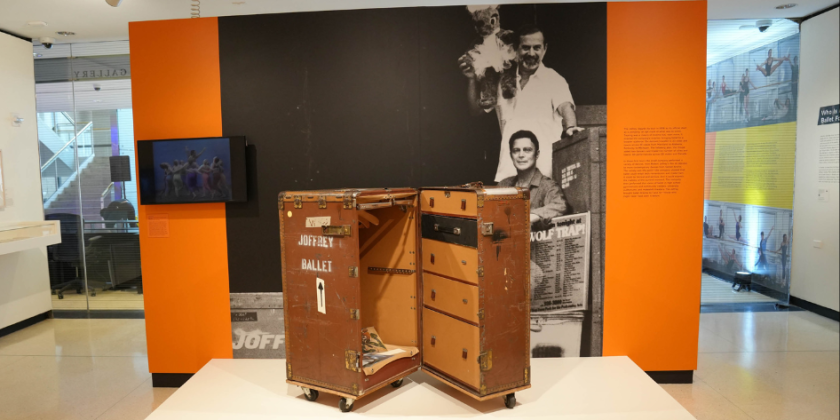IMPRESSIONS: Dance Theatre of Harlem: A History, A Movement, A Celebration - Book by Judy Tyrus and Paul Novosel

DAFINA BOOKS, Kensington Publishing Corp., 2021. 292 pages. $50.
www.kensingtonbooks.com available here
By Robert Johnson
When Dance Theatre of Harlem presented a choreographic adaptation of A Streetcar Named Desire in 1982, Arthur Mitchell, the troupe’s artistic director, received a beguiling telegram from playwright Tennessee Williams. “Success and all that,” Williams cabled, “but remember the road to success is paved with mad ideas.”

Mitchell didn’t need this teasing reminder. He had already shown himself willing to entertain “mad ideas.” While the former New York City Ballet star had enjoyed an extraordinary dance career, in 1968, the year he launched the ballet program at the Harlem School of the Arts, Mitchell was arguably crazy to think he could field a whole company of African American ballet dancers. Unlike modern dance, ballet remained chained to traditional, European conceptions of beauty. Prejudice against African Americans in ballet was taken for granted; homophobia was everywhere; and no such venture had survived before. Yet the 1960s were a time of limitless possibility. Confounding expectations, by the 1980s Dance Theatre of Harlem would ride a wave of triumph.

The story didn’t end there, however, as Judy Tyrus and Paul Novosel explain in their fascinating and long-overdue book, Dance Theatre of Harlem: A History, a Movement, a Celebration, which appeared last year. Within another decade, the temperature in America had changed. It began to emerge that the “mad” part of Arthur Mitchell’s mad idea was not launching a ballet company from a Harlem garage but imagining that when this company prospered, growing into a fully-fledged institution, philanthropists would provide it with the same level of support they provided to European American artists. That didn’t happen. When the company became expensive to operate, its very success proved its undoing. The funds required to mount elaborate productions with a live orchestra were not forthcoming in the 1990s, when arts funding shrank. DTH experienced a near-death event in 2004. Then Tennessee Williams’ message resounded eerily, as like others in the not-for-profit sector Mitchell discovered the perils of depending upon the kindness, and the largesse, of strangers.

Dance Theatre of Harlem was too special, however, and the need for it was too great for it to go under. In 2012 the troupe rebounded, drastically reduced in size, under the direction of its incandescent prima ballerina Virginia Johnson. Despite the challenges all performing arts organizations now face in the wake of Covid-19, DTH may yet go far.
Whatever the future brings, Tyrus and Novosel’s book will stand as witness to the company’s decades of untrammeled glory and its ongoing struggle to adapt to a meaner and less art-friendly world. Meticulously researched, lavishly illustrated, and inspiring, this publication is a must for every dance lover’s bookshelf. Supplementary materials are available on-line at: DTHbook.org.

A former DTH ballerina, Tyrus carries the company’s history in her body. She is also an archivist and curator whose work on the landmark 2009 exhibition Dance Theatre of Harlem: 40 Years of Firsts, co-curated with Barbara Cohen Stratyner, laid the groundwork for the current publication. The book presents the company’s history chronologically, yet the authors have also arranged their material thematically in the manner of an exhibition. The book’s method of organization suggests an Africanist collage; and the brevity of sections devoted to different topics makes the material accessible, so it will be useful to students and professional researchers alike.
Discrete sections highlight the contributions of individuals, such as legendary wardrobe mistress Zelda Wynn, or phenomena such as the Dancing Through Barriers initiative. Going beyond the history of the dance company, Tyrus and Novosel document the activities of DTH’s affiliated school, its allied arts programs, social outreach, and the ideals that made this organization a city on a hill, locating it within the tradition of American Utopian communities.

Nikki Hefko with student; Photo: Judy Tyrus
Arthur Mitchell, Dance Theatre of Harlem’s founding artistic director, deserves a full-scale biography, but in the meantime ballerina Judy Tyrus and pianist Paul Novosel have sketched the essentials in the opening chapter of their book, Dance Theatre of Harlem: A History, a Movement, a Celebration. Illuminating Mitchell’s life and character, the authors point to his remarkable ability, when coaching, to dissect and explain movement; to his insistence upon a dignified appearance; and to the relentless work ethic that he instilled in every company member.
Tyrus and Novosel also offer an amusing portrait of DTH co-founder Karel Shook, a charismatic teacher who dispensed advice about dieting and sex while supervising the dancers’ daily exercises; and whose philosophical writings underpinned the company’s mission.

Karel Shook and Arthur Mitchell; Photo: Marbeth
One can only marvel at the irrepressible life-force that allowed Mitchell, as a young man, to rise above circumstances that included poverty, his father’s incarceration, and the death of an older sister. Initially, he studied modern dance at the Performing Arts School (now Fiorello H. LaGuardia High School of Music & Art and Performing Arts). Mitchell also performed with the companies of Donald McKayle and John Butler before joining George Balanchine’s New York City Ballet. These early experiences complemented the refined movement education that Mitchell received from Russian ballet teachers including Felia Doubrovska and from Balanchine himself.
The authors quote dance critic Anna Kisselgoff’s insightful observation that by stripping ballet of its costumes, scenery, and cultural signifiers, Balanchine created a neutral space in which an African American dancer like Mitchell could perform. Appearing in tights and a white T-shirt, Mitchell could be himself on stage in a way that DTH dancers Christina Johnson and Ronald Perry still could not in 1990, when (to their horror) they were invited to wear blond peruques during guest appearances with Britain’s Royal Ballet.

Photos of Mitchell dancing reveal the exquisite clarity of form that he learned from Balanchine, and the classical style that shaped his talent. Yet Mitchell’s conception of ballet was not confined to the stripped-down, mid-century-modern aesthetic of Balanchine’s Agon. When Tyrus and Novosel quote Mitchell as saying, “Even when I am working on abstract pieces, I try to give myself an emotional story line,” that is not Balanchine talking but Stanislavski.

Later, the authors quote Mitchell again: “It was called Dance Theatre of Harlem, not Ballet Theatre of Harlem, because it is theatrical dance grounded in classical ballet.” Mitchell’s broad vision of dance as theater was a key to his success as an artistic director, enabling him to forge an identity for his company outside Balanchine’s narrow aesthetic. This diversity also dispelled the notion that African American dancers had any limitations whatsoever.
During its heyday as a major cultural institution, DTH’s eclectic repertoire would honor its African and Caribbean heritage in spectacular creations with choreography and designs by Geoffrey Holder: Bele, Dougla, and Banda. DTH celebrated “Americana” with productions of Billy the Kid, Frankie and Johnny, and Fall River Legend. It revived Ballets Russes masterpieces by Michel Fokine and Bronislava Nijinska (notably the neo-classical Les Biches); and it met the challenge of the 19th-century repertory performing staples like Giselle, Flower Festival in Genzano, and Paquita. The company presented works by African American choreographers like Billy Wilson; while productions by Glen Tetley epitomized the fusion of ballet and modern dance. Mitchell understood that this diversity and his dancers’ acting skills enriched their performance of plotless ballets.

Perhaps Tyrus and Novosel should give more credit to the example of the Ballets Russes, where mastering the art of dramatic expression similarly infused life into the dancers’ classical style. Mitchell did not perform with the Ballets Russes or its legacy troupes, but DTH co-founder Karel Shook did; and other Ballets Russes veterans, notably Frederic Franklin and Alexandra Danilova, were enthusiastic DTH collaborators.
The theatricality that is popular with audiences is not always popular with critics, however, especially in New York City. Parochial attitudes contributed to a disaster in 2003, when Mitchell bet the farm on an extravagant production of St. Louis Woman: A Blues Ballet, with choreography by Michael Smuin. Tyrus and Novosel choose to quote a critical attack on this work (the only negative review cited in their book), whereas I recall St. Louis Woman as a thrilling production offering wonderful opportunities to its all-star cast. In my critical opinion, that ballet would be well worth reviving---minus Tony Walton’s beautiful but hard-to-tour scenery. While generally upbeat, Tyrus and Novosel strive to maintain a neutral stance, assembling DTH’s history from a list of places, names, and dates (“Just the facts, ma’am”) rather than offering a critical perspective that would discriminate, for example, between barnstorming spectacles like Firebird and Dougla and subtler, modern creations like Garth Fagan’s Footprints Dressed in Red or Glen Tetley’s Dialogues (both fabulous DTH commissions).

Tyrus and Novosel are conscientious and remarkably thorough in documenting the company’s activities, and yet there are lacunae. Notable for its absence is the company’s 1995 season at the Brooklyn Academy of Music, when Mitchell’s insistence on live music and adequate rehearsal time (the nerve!) put the company in debt and triggered an attempted coup by the board of directors. Perhaps, even now, the backstage intrigue is too knotty for Tyrus and Novosel to unravel. Yet it seems a shame to pass over a season that included magnificent performances of Balanchine’s Prodigal Son, Robert Garland’s choreographic debut in Joplin Dances, Alonzo King’s Signs and Wonders, and Smuin’s controversial, but wildly popular Songs for Dead Warriors.
Evidently the past is an earthquake, and DTH has lived through more than 50 years of profound change frequently at the epicenter. The troupe toured to the Soviet Union when there still was a Soviet Union. It visited South Africa on the cusp of a new, post-Apartheid era. It endured the brutal AIDS epidemic, and it soldiered through the aftermath of 9/11. Arthur Mitchell died in 2018, taking a lifetime of wisdom with him. Now leaner and lighter, DTH is dealing with the oppressive strictures that have accompanied Covid.
What may be hard for young people reading this history to understand is the feeling of the past. The idealism, hopefulness, and sexual freedom of 1968 were exhilarating beyond measure, but they began to be replaced by greed, cynicism, and fear during the 1980s, the decade that launched a conservative revanche. The AIDS epidemic did not only signify the loss of individual talents----Paul Russell, Carld Jonaissant, and the brilliantly promising Calvin Shawn Landers among them. Fear of contagion imposed a deadening atmosphere on society at large. As DTH was enjoying its great expansion in the 1980s, simultaneously the ground was being laid for the Culture Wars that broke out in 1989 over a Robert Mapplethorpe exhibition at the Corcoran Gallery. At that precise moment, a sea change began in arts funding leading to a grim period of retrenchment.













